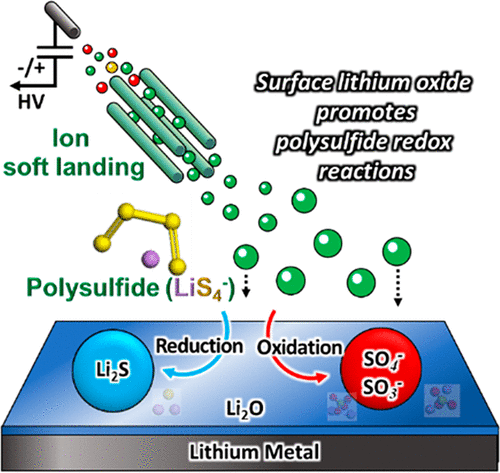当前位置:
X-MOL 学术
›
J. Phys. Chem. Lett.
›
论文详情
Our official English website, www.x-mol.net, welcomes your feedback! (Note: you will need to create a separate account there.)
Role of Polysulfide Anions in Solid-Electrolyte Interphase Formation at the Lithium Metal Surface in Li–S Batteries
The Journal of Physical Chemistry Letters ( IF 5.7 ) Pub Date : 2021-09-22 , DOI: 10.1021/acs.jpclett.1c01930 Kie Hankins 1, 2, 3 , Venkateshkumar Prabhakaran 1, 2 , Sungun Wi 1, 2 , Vaithiyalingam Shutthanandan 2 , Grant E Johnson 1, 2 , Swadipta Roy 1, 2 , Hui Wang 1, 2 , Yuyan Shao 1, 2 , Suntharampillai Thevuthasan 2 , Perla B Balbuena 3 , Karl T Mueller 1, 2 , Vijayakumar Murugesan 1, 2
The Journal of Physical Chemistry Letters ( IF 5.7 ) Pub Date : 2021-09-22 , DOI: 10.1021/acs.jpclett.1c01930 Kie Hankins 1, 2, 3 , Venkateshkumar Prabhakaran 1, 2 , Sungun Wi 1, 2 , Vaithiyalingam Shutthanandan 2 , Grant E Johnson 1, 2 , Swadipta Roy 1, 2 , Hui Wang 1, 2 , Yuyan Shao 1, 2 , Suntharampillai Thevuthasan 2 , Perla B Balbuena 3 , Karl T Mueller 1, 2 , Vijayakumar Murugesan 1, 2
Affiliation

|
Delineating intricate interactions between highly reactive Li-metal electrodes and the diverse constituents of battery electrolytes has been a long-standing scientific challenge in materials design for advanced energy storage devices. Here, we isolated lithium polysulfide anions (LiS4–) from an electrolyte solution based on their mass-to-charge ratio and deposited them on Li-metal electrodes under clean vacuum conditions using ion soft landing (ISL), a highly controlled interface preparation technique. The molecular level precision in the construction of these model interfaces with ISL, coupled with in situ X-ray photoelectron spectroscopy and ab initio theoretical calculations, allowed us to obtain unprecedented insight into the parasitic reactions of well-defined polysulfides on Li-metal electrodes. Our study revealed that the oxide-rich surface layer, which is amenable to direct electron exchange, drives multielectron sulfur oxidation (S0 → S6+) processes. Our results have substantial implications for the rational design of future Li–S batteries with improved efficiency and durability.
中文翻译:

多硫化物阴离子在锂硫电池锂金属表面固体电解质界面形成中的作用
描绘高反应性锂金属电极与电池电解质的不同成分之间复杂的相互作用一直是先进储能设备材料设计中长期存在的科学挑战。在这里,我们根据质荷比从电解质溶液中分离出多硫化锂阴离子 (LiS 4 – ),并在清洁真空条件下使用离子软着陆 (ISL)(一种高度受控的界面制备)将它们沉积在锂金属电极上技术。构建这些模型与 ISL 接口的分子水平精度,再加上原位X 射线光电子能谱和ab initio理论计算使我们能够前所未有地深入了解锂金属电极上定义明确的多硫化物的寄生反应。我们的研究表明,易于进行直接电子交换的富含氧化物的表面层驱动了多电子硫氧化(S 0 → S 6+)过程。我们的研究结果对未来锂硫电池的合理设计具有重大意义,以提高效率和耐用性。
更新日期:2021-09-30
中文翻译:

多硫化物阴离子在锂硫电池锂金属表面固体电解质界面形成中的作用
描绘高反应性锂金属电极与电池电解质的不同成分之间复杂的相互作用一直是先进储能设备材料设计中长期存在的科学挑战。在这里,我们根据质荷比从电解质溶液中分离出多硫化锂阴离子 (LiS 4 – ),并在清洁真空条件下使用离子软着陆 (ISL)(一种高度受控的界面制备)将它们沉积在锂金属电极上技术。构建这些模型与 ISL 接口的分子水平精度,再加上原位X 射线光电子能谱和ab initio理论计算使我们能够前所未有地深入了解锂金属电极上定义明确的多硫化物的寄生反应。我们的研究表明,易于进行直接电子交换的富含氧化物的表面层驱动了多电子硫氧化(S 0 → S 6+)过程。我们的研究结果对未来锂硫电池的合理设计具有重大意义,以提高效率和耐用性。


























 京公网安备 11010802027423号
京公网安备 11010802027423号